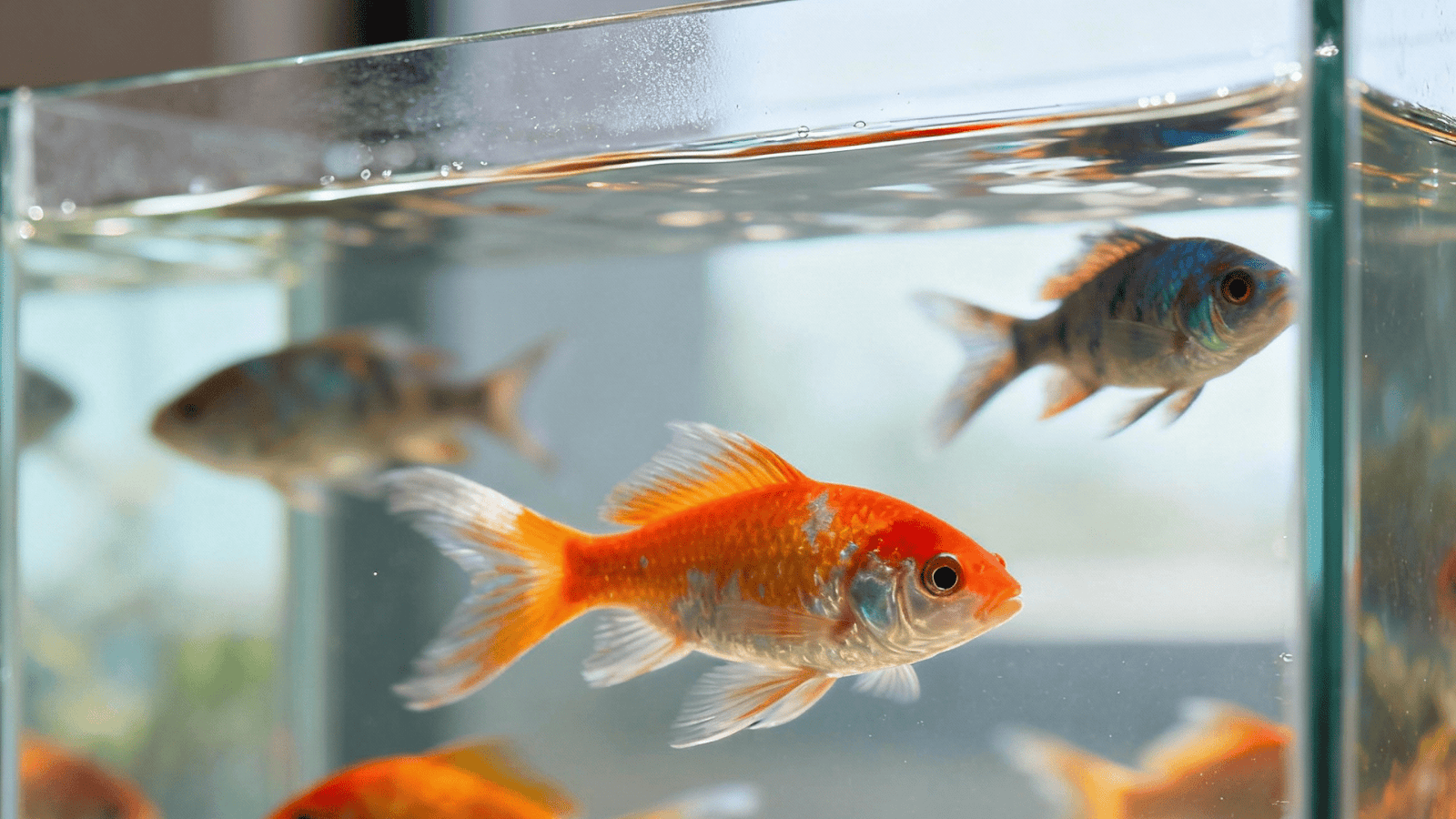How To Fix Hazy Or Foggy Aquarium Glass With Cerium Oxide [2025]


If your aquarium glass looks permanently foggy, even after scrubbing it with vinegar, razor blades, or every cleaning solution under the sun, you’re not dealing with dirt.
You’re dealing with etched glass.
After 30+ years building and restoring aquarium display panels for public aquariums, zoos, and high-end home installations, I’ve seen this countless times. Hard water minerals and condensation can chemically erode the surface of glass, leaving behind a cloudy haze that’s physically carved into the surface, not sitting on top of it.
The good news? There is a fix, and it’s cerium oxide.
This ultra-fine polishing compound is the same material we’ve used in professional aquarium fabrication shops to restore clarity to glass windows worth $10,000+. And with the right method, you can use it at home to polish your foggy aquarium glass back to crystal clear.
Now, in this article, I have decided to share my experience with everyone about how this is done. In this guide, you will get a step-by-step approach and pro tips that you probably won’t find elsewhere (as I write out of experience).
So let’s begin.
TL;DR — Quick Takeaways

- Foggy aquarium glass is usually etched, not dirty. Normal cleaning won’t fix it.
- Cerium oxide is the only reliable DIY method to polish etched glass back to clarity.
- You’ll need an electric drill + buffing pad + cerium oxide slurry. Expect several hours of polishing per panel.
- Keep the glass wet while polishing. Overheating can crack it.
- Deep scratches? Cerium oxide won’t remove them. You’ll need sanding or acrylic filler instead.
- If it seems too severe, consult with experts (like Hammerhead Aquatics) for the right direction or service.
Now, let’s get into the details.
What Causes Foggy or Hazy Aquarium Glass?

There could be only 3 main reasons for your aquarium glass to become hazy.
1. Hard Water Etching (Most Common)
Mineral deposits dry onto the glass repeatedly. Over time, they chemically bond and erode the surface, leaving behind a white, frosted appearance.
2. Condensation Damage
In humid terrariums, paludariums, or tanks with cold rooms + warm water, condensation forms. This water absorbs CO₂, becoming slightly acidic, dissolving minerals out of the glass itself.
3. Incorrect Cleaning
Household sponges, sand-contaminated pads, or scrubbing with baking soda can micro-scratch the glass, making it look permanently smeared.
Why Cerium Oxide Works (When Cleaning Doesn’t)

Unlike cleaning agents, cerium oxide isn’t for wiping, it’s for polishing.
It’s a glass-safe abrasive, fine enough to buff away micro-layers of etched glass, restoring a smooth, transparent surface without distorting the panel.
This is the same compound used in optical lens manufacturing and automotive windshield repair, and it works just as well on aquarium glass (and even acrylic, with care).
What You Need to Polish Aquarium Glass with Cerium Oxide
- Cerium oxide powder (main polishing agent; buy 8–16 oz, you’ll use more than you think)
- Electric drill or rotary tool (spins the polishing pad; corded preferred for long sessions)
- 3–4 felt/cloth buffing wheels (holds the cerium slurry; avoid foam pads as they disintegrate)
- Spray bottle or water dish (keeps polishing area wet, prevents overheating and cracking)
- Microfiber cloths (for cleanup; avoid towels that shed fibers)
- Painter’s tape (protects seams and silicone; optional but recommended)
- Eye protection, respirator, gloves (for safety; cerium oxide is non-toxic but dusty)
Step-by-Step: How to Polish Foggy Aquarium Glass with Cerium Oxide

Step 1: Empty & Clean the Tank Thoroughly
First, remove all fish, livestock, substrate, and decorations.
Then rinse the inside completely. Even one grain of sand can scratch glass during polishing.
Once done, dry the glass surface.
Step 2: Prepare Your Polishing Slurry
You have to mix cerium oxide with the right materials. You do it in two ways:
- Slurry Dish Method (Pro Preferred):
→ Pour water into a shallow dish
→ Add 1–2 tbsp cerium oxide
→ Stir lightly
→ Dip pad directly - Mist Bottle Method:
→ Spray water on glass
→ Sprinkle cerium oxide over it
Avoid thick paste. It flies off when the buffing wheel spins.
Step 3: Start Polishing in Circular Motions
Now, attach the buffing wheel and dip it into slurry, And then press flat and evenly against the glass.
Use medium pressure. Do not press too hard (you’re polishing, not grinding)
Always keep circulating and moving. Do not keep hovering over one spot.
⚠️ Never let the glass heat up. If it feels warm to touch, pause or spray more water.
Step 4: Check Progress Frequently
After polishing, wipe the area dry with a microfiber cloth. Then check the area from different angles. Use a flashlight or headlamp to find small flaws. If haze remains, continue polishing and check again.
Step 5: Rinse and Final Clean
Once it seems good, remove all cerium residue with water + sponge. Then vacuum out the remaining powder with a siphon inside the tank. They let it dry.
You should now see 90–100% clarity restored
How Long Does It Take?
- 10–20 Gallon Tank Panel: 1–2 hours of polishing time
- 40–55 Gallon Tank Panel: 3–4 hours of polishing time
- 75 Gallon Tank Panel: 5–8 hours of polishing time (may require multiple sessions)
- Yes, it’s a workout. But the results make an old tank look brand new.
Yes, it’s a workout. But the results make an old tank look brand new.
Can Cerium Oxide Fix Scratches Too?

So, you might think this will also fix scratches on your aquarium. But…not quite.
For light surface scratches? Yes. It may work.
But for deep scratches you can feel with your fingernail? No.
For deeper scratches, you’ll need wet sanding (400–1600 grit) before cerium polishing, or, if it’s acrylic, use a plastic scratch removal kit.
Alternatives to Cerium Oxide (When Not Worth the Effort)
- Replace the panel
- When to use: Large tanks with heavy etching
- Downsides: Costly, needs resealing
- New aquarium
- When to use: If polishing takes longer than the value of the tank
- Downsides: Economical for small tanks only
- Acrylic polish (Novus, Meguiar's, etc.)
- When to use: For acrylic tanks only
- Downsides: Can haze if used on glass
Final Thoughts

Cerium oxide polishing is the only reliable DIY method to restore foggy or etched aquarium glass back to near-new clarity. But it requires patience, consistency, and the right tools.
If you’re restoring a display tank, it’s absolutely worth it.
If it’s a breeding tank in the basement?
Maybe not. Your time is worth something too.
But if you do it right, the satisfaction of watching that first crystal-clear view emerge through the haze?
Priceless.
However, there is a “but”.
I did make it seem easy for a DIY project. But do remember, aquariums don’t come cheap, and if you have built a custom aquarium window, then it will be risky to get this done by someone with no experience. So, if you are less confident, it’s better to call in some experts for it.
Expert Aquarium Window Design & Installation

Thinking bigger than just polishing a small tank?
I’ve spent over two decades designing custom ultra-clear aquarium windows for homes, restaurants, and public exhibits. Whether you need:
- ✅ Low-iron, museum-grade glass panels
- ✅ Seamless viewing windows with zero optical distortion
- ✅ Acrylic installations for curved or oversized tanks
So if you think you need professional help with your existing aquarium or want to build a new one, you can get in touch with us at Hammerhead Aquatics. Simply reach us for a free quote before making a decision.
But if you have any questions about what I explained in the article, you may leave a comment and I will try to answer from my experience.
Frequently Asked Questions
1. Can I use toothpaste or baking soda instead of cerium oxide?
No. Those are far too weak. They can remove fingerprints but won’t touch etched glass.
2. Will polishing weaken the glass?
Not if done properly. Polishing only removes a tiny amount of glass, just microns (much thinner than a millimeter). As long as you keep the surface wet, move the polisher evenly, and don’t stay in one spot too long or let it overheat, it’s perfectly safe.
3. Does cerium oxide work on acrylic tanks?
Yes, but use lower pressure and slower speed. Acrylic scratches faster than glass.
4. Can I polish glass while the fish are still inside?
Absolutely not. Empty the tank completely. Cerium particles can irritate gills and damage filter systems.
5. Will hazing come back after polishing?
Only if the water conditions stay the same. Reduce etching by:
- Keeping waterline deposits cleaned regularly
- Using RO/DI or softened water
- Improving ventilation to reduce condensation
If you’re facing foggy aquarium glass, using cerium oxide is the safest and most effective approach for lasting clarity, especially for display and premium tanks. For large, valuable windows or persistent haze, consider professional restoration to avoid risks. Regular waterline cleaning, use of softened or RODI water, and proper ventilation minimize future hazing. For ultra-clear custom aquarium glass, seamless viewing windows, or major repairs, reach out to Hammerhead Aquatics for a free quote and specialist help. Don’t settle for cloudy views, restore and maintain the true beauty of your aquarium glass.











